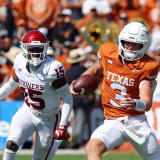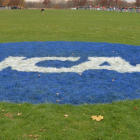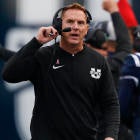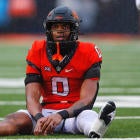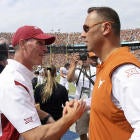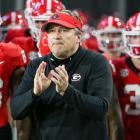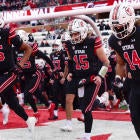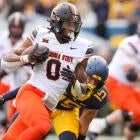
Inside a conference room Monday, eight Supreme Court justices will decide what additional cases to hear this term. One of the petitions may determine the future of college sports: Case No. 15-1388, NCAA v. Ed O'Bannon.
At stake is whether the highest court in the United States of America will hear O'Bannon to settle the debate over amateurism, or pass on the issue temporarily and maybe forever. The NCAA wants the case heard so it can keep using amateurism as a key defense for a model preventing athletes from being paid. O'Bannon's lawyers want it heard to allow players to make money off their name, image and likeness, and to settle antitrust questions for possible future legal challenges of NCAA rules.
All that matters, of course, is whether the Supreme Court wants to hear it. What the NCAA and O'Bannon view as a vital issue doesn't necessarily carry the same weight with the court, which will review challenges on issues such as transgender bathrooms, the Washington Redskins' trademarks, Obamacare and the President's ability to fill justice vacancies without Senate approval.
The Supreme Court grants about one percent of the 7,000 petitions it hears each year. Lately, the court's docket has been historically light, which court experts believe is due to Justice Antonin Scalia's death.
It's unusual but not unprecedented that the NCAA and O'Bannon both want the same question answered (amateurism), said Stephen Wermiel, a constitutional law professor at American University who writes a column on SCOTUSBlog about the Supreme Court.
"I do think that makes it more likely for the case to be heard," Wermiel said. "If I were betting, I might bet they'd deny it. I think these are issues they're eventually going to have to decide. But whether they're ready for that now, I don't know."
Here's what to watch for as the Supreme Court evaluates O'Bannon:
What are the O'Bannon and NCAA arguments? Last September, the 9th Circuit Court of Appeals upheld that the NCAA violated antitrust law, but it eliminated a lower court's remedy allowing schools to pay football and men's basketball players $5,000 per year. The O'Bannon lawyers want the $5,000 remedy back and clarification of amateurism. They also believe the 9th Circuit improperly put the burden on the plaintiffs to show the $5,000 payments were appropriate.
The NCAA also wants amateurism answered once and for all. The 9th Circuit decision means only cash tied to educational expenses, such as cost of attendance, is allowed under NCAA rules.
The NCAA contends that NCAA v. Board of Regents in 1984 should have resulted in a more favorable ruling for the NCAA in O'Bannon. The 1984 case was about college football television rights, but a small portion of the Supreme Court's opinion said that athletes must not be paid in order to preserve the NCAA's product.
The NCAA is also asking the Supreme Court to consider whether First Amendment protections should have factored into O'Bannon, which focused on using players' images in video games without their permission. If nobody owned the rights to athletes' names, images and likenesses, the NCAA argues, the association didn't restrain trade.
What does the Supreme Court look for in taking cases? Typically, the Supreme Court considers if there's a difference of opinion between the federal court and court of appeals, and if the conflict is important enough for the Supreme Court to decide. Four justices must vote in favor of a case being heard.
"Ordinarily, they might wait for another court to say amateurism is immunity and then they have a square conflict to hear it," Wermiel said. "Here, since it's their own opinion [that's in conflict from the 1984 Board of Regents case], they might take the bull by the horn and hear it."
Because there are only eight justices, cases that are heard and end in a 4-4 tie revert to the appeals court decision and don't set Supreme Court precedent. If the court is split 4-4 on whether to hear O'Bannon, it might hold the case until a ninth justice arrives since a 4-4 final ruling wouldn't accomplish much, Wermiel said.
What is the process for deciding Supreme Court cases? Monday is what is called the "long conference" for the Supreme Court -- the first one in months and which may include more than 1,000 petitions. A law clerk for one justice already reviewed the O'Bannon case and wrote a memo summarizing the issues. Seven of the eight justices participate in this process, which is called a cert pool, to manage the volume of petitions. The memo gets shared with the seven justices in the pool and a recommendation is made on whether to hear the case.
Samuel Alito is the only justice not in the cert pool. He uses his own law clerk to review cases so there's a different viewpoint. Chief Justice John Roberts will then circulate a discuss list of possible cases to be heard. If O'Bannon doesn't make this list of perhaps 50-75 cases, it's denied and the justices don't vote.
When will we know if O'Bannon will be heard? It's unclear. The Supreme Court will likely announce Wednesday or Thursday the cases it's hearing based off Monday's conference, Wermiel said. The cases that are denied are expected to be released Oct. 3. It's possible O'Bannon could be on neither list and still be granted. Sometimes the court takes additional time to decide.
If a petition is granted, O'Bannon will be scheduled for oral arguments, possibly in January or February and with a final ruling in June. If the petition is denied, the NCAA won't make its fourth appearance ever before the Supreme Court -- at least not yet. The Jeffrey Kessler case regarding paying players is still playing out in the lower courts.


